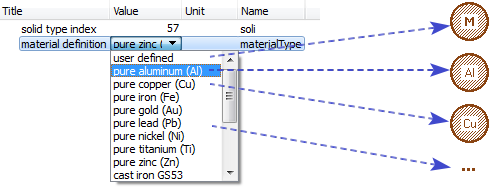THSD00-Thermal Solid Properties Generic
Description
THSD00 defines the thermal properties of a solid material. Thermal properties are the density (ρ), the specific heat (Cp), and the thermal conductivity (λ). In THSD00, thermal properties can be specified either:
- By choosing among a list of predefined materials
- By setting the thermal properties as constant
- By setting the thermal properties as a function of the temperature (polynomial or user-defined tables or mathematical expressions)
Usage
Use THSD00 when you want to define the thermal properties of a solid material. THSD00 differs from THSD01 in that the latter can model PCM (Phase Change Material).
Parameter Settings
The "solid type index" is a unique identifier for the solid material defined by THSD00. Depending on the user choice between predefined solid materials or a user-defined specification, the icon varies in order to enhance the model readability.

In the case of a "user defined" solid material, the user is asked to either:
- Set the thermal properties as constant values.
- Set the thermal properties as polynomials whose coefficients are stored in an ascii file. The ascii file should contain the following data:
- T0, definition temperature [degC]
- rho0, definition density [kg/m**3]
- cp0, definition specific heat [J/kg/K]
- lam0, definition thermal conductivity [W/m/K]
- tmin, minimum temperature allowed [degC]
- tmax, maximum temperature allowed [degC]
- rhot, temperature coefficient for density
- rhot2, squared temperature coefficient for density
- cpt, temperature coefficient for specific heat
- cpt2, squared temperature coefficient for specific heat
- lamt, temperature coefficient for thermal conductivity
- lamt2, squared temperature coefficient for thermal conductivity
allowing to define the thermal properties as second order polynomials:
The coefficients of these polynomials have to be reckoned by fitting on experimental measures. Two different tools may be used to do that:
-
the Media Property Assistant
-
or the Solidgen utility
-
Set the thermal properties as tables or mathematical expressions. The user can:
- Either set a valid mathematical expression function of T the temperature of the solid material in degC like
903*(1+6.893e-04*(T-27)-1.694e-07*(T-27)^2). For a full list of functions available for use in expressions, see the documentation for CheckExpression. - Or set a path to an ascii file like
./data/my_material_density.datain the following format: 1D Table.
- Either set a valid mathematical expression function of T the temperature of the solid material in degC like
The tMin and tMax parameters are used to define a validity domain for the specified thermal properties. A warning will be sent during the simulation if this validity domain is crossed but the thermal properties are computed as set by the user whatever the temperature. In any of the previous case, the "name of the solid" parameter is a string that is free to set by the user to help him remember or explain the setting of the solid material properties. It does not affect the simulation in any way.
Sketches and Equations
The total mass is the sum of all thermal masses defined in your model and that share the same "solid type index", for instance THC000, but also THDYNWALL, THDYNCYLWALL and submodels belonging to other libraries such as ACMCTFINT1 and so on. The total energy is defined as the integration over time of the incoming heat flux on all thermal masses that share the same "solid type index" in your model. This calculation is done in the thermal masses and is optional (see THC000 for instance).
See also
- Media Property Assistant